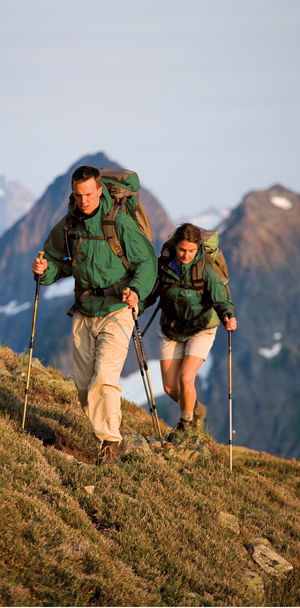« Smith Haven Scratch Resistant Sunglasses – Review | Main | Lowrance Endura Sierra Handheld GPS Unit For The Great Outdoors »
Keeping Your Knees In Good Health – On The Trail – Part 2
By Editor | September 26, 2010

Most of the time when knee injuries happen it is because of the twisting type moves that people do to regain their balance. Trekking poles assist in making loads seem lighter and even as it offers balance and stability and without trekking poles you only have your muscles and ligaments to balance you which makes you prone to knee injuries. With trekking poles however you have more points of contact (3 to 4) and this helps your knees.
When lowering yourself down a steep drop, using double poles to plant yourself is useful. Placing both poles simultaneously and slowly easing yourself down will lessen the chance of injuries. Using the poles as an extension of your arms is the trick and it is recommended you do not use telescoping poles, as sometimes the telescopic pole gives way due to your weight you can take a bad fall and severely injure yourself.
Stretch First and Avoid Straining
While hiking if you feel your knees start to tingle or twinge, drop your backpack and take a moment to do some leg stretches. Your knees and entire leg will feel much better.
Loosening the muscles eases the strain and tendons and ligaments, while reducing the chances of inflaming and tearing the muscles. To do this properly you will need to stretch for at least 10-15 minutes after a resting period like lunch or nap and the muscles to concentrate on are quads, hamstring, calves and ankles.
Don’t Buckle the Knee
Always keep knees slightly bent when stepping down. To land on any surface when your knees are straight and locked can be very painful and dangerous. It is like a car with no shocks, you will feel the shock and pain shoot up your body…try to be mindful of where and how you are stepping down.
Allow the knees to bend and your muscles to absorb the weight. Now, if you are a person who has a knee that tends to lock, you should be working on strengthening your legs with exercises at home and pack your backpack lighter to avoid injuries.
Descending by Climb Down Ladder Method
When a steep drop off or slope is encountered try going down the steep slope backward, kind of like you are climbing down a ladder with your stomach facing the ground. This technique will use your strongest uphill muscles which is the hamstring and glutes to assist you downhill or off boulders and ledges, it is like hiking in reverse, but stepping backwards to reduces the jolt to your knees.
Verify Your Alignment
When walking around objects and obstacles check your angle of step. Sometimes, stepping around an obstacle and landing your leg / feet at an awkward angle can spell injury. This misstep can sometimes result in twisty and straining the knee. Remember at awkward angles your knee ligaments and muscles have to work harder at keeping your ankle from rolling and your kneecap tracking straight.
Always Look Before You Leap
Evaluate any drop off carefully. If it looks too high, remember never try to go for it and jump. Don’t jump is better to avoid injuries…remember if you have been hiking for 5 hours or more your muscles are already fatigued and your muscles will not be able to help you avoid twisting or breaking something.
Don’t Follow the Leader
Ever followed a friend on the trail who is taller than you? Well is step are probably much longer and wider and to follow this friend might mean you are straining yourself.
Instead of following the leaders footstep exactly try to follow it as best as you an but adjust the length and width of the steps so that it is more comfortable and less stress for your knees and legs.
Bookmark at:StumbleUpon | Digg | Del.icio.us | Dzone | Newsvine | Spurl | Simpy | Furl | Reddit | Yahoo! MyWeb
Topics: Articles, Camping, Hiking and Backpacking, General | 279 Comments »



